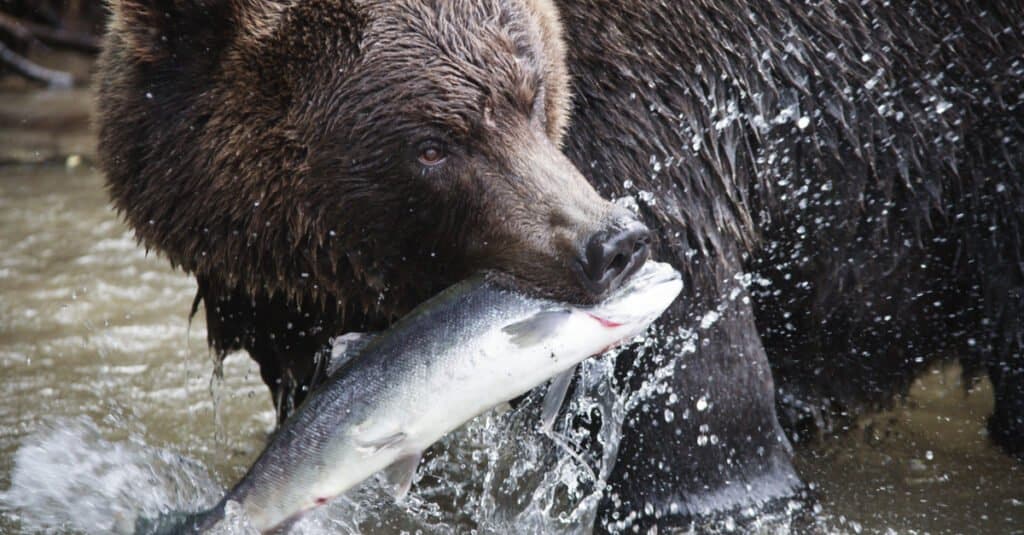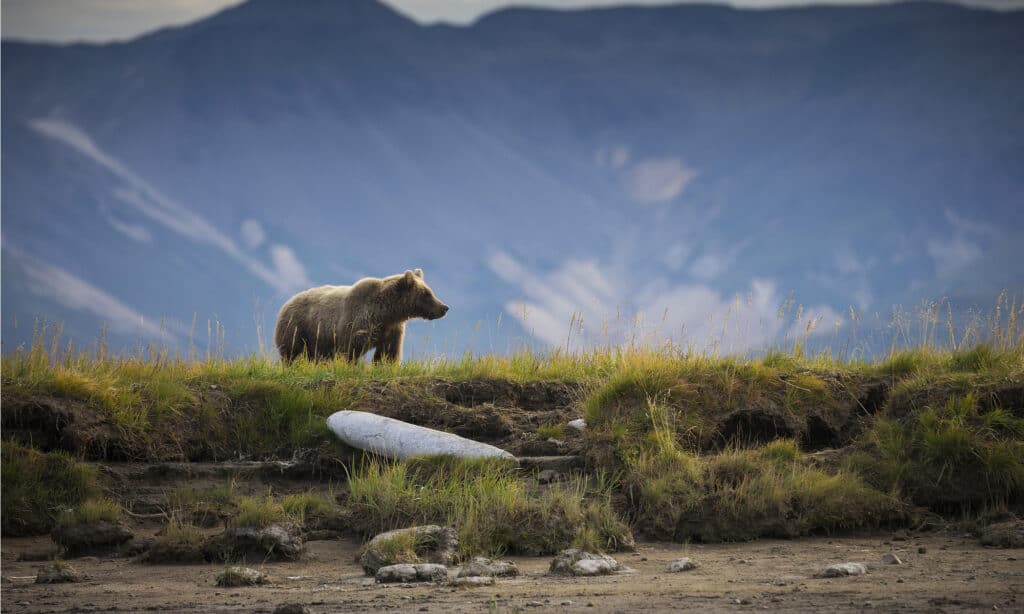One of the most iconic wildlife images is that of a grizzly bear salmon fishing. The enormous and majestic animals seem to have quite a delicate touch when it comes to seeking out their favorite food. And wildlife photographers (as well as tourists) flock to places where they can watch this spectacular feat. Of course, it is no secret that grizzly bears feast on salmon to pack on fat and calories in the late summer and early fall. But how big do the bears actually get? And what is the world’s fattest bear?
In the article below, you will meet the world’s fattest bear and learn all about his environment. Where does the world’s fattest bear get its food? And what else lives nearby?
Continue reading to find out the answers to these questions.
Meet ‘Bear Force One’
Every year there is a competition of sorts. In it, grizzly bears compete for the title of “fattest bear.” The event is known as Fat Bear Week. The online competition relies on the voting public to cast their ballots. Twelve bears from Katmai National Park & Preserve in Alaska are selected annually to go head-to-head in an elimination bracket-style competition. And even making it that far is an impressive feat since an estimated 2,200 bears live in the National Park.
For the second time in the last three years, one bear outsized the rest in the 2022 competition. It is Bear 747, more affectionately known as “Bear Force One.”
Bear Force One is about 20 years old, and researchers estimate his weight at approximately 1,400 pounds. He reaches that enormous weight thanks to his salmon-rich diet. Bear 747 has achieved dominance at one of the best fishing spots on the Brooks River. One former park ranger witnessed Bear Force One eating 15 sockeye salmon in one fishing expedition.
The enormous bear first won the title of the world’s fattest bear in 2020, then lost it the following year. So, for many participants of Fat Bear Week, Bear Force One’s second victory is a huge success!

Grizzly bears go fishing in Brooks River during the salmon run every year.
©Michal_K/Shutterstock.com
What Are Grizzly Bears?
We know them as grizzly bears. However, their official name is North American Brown Bears (Ursos arctos horribilis). The impressive animal was nearing extinction earlier in the 20th century. They got saved after getting listed in the Endangered Species Act of 1973. Over the decades, they have started to make a serious comeback, and the population of grizzly bears is beginning to boom.
Grizzly bears are native to the North American continent. The large animal lives a mostly solitary life. But they come together during mating season, and the protective moms watch over cubs until they are old enough to venture out on their own.
Everyone knows that grizzly bears are large. But it is hard to picture exactly how massive the impressive animals get. Their height (standing on hind legs) ranges between 7 and 10 feet. And their weight is even more impressive. Grizzly bears can reach between 400 and 800 pounds during the spring and early summer. Male brown bears are typically on the higher end of the scale. However, brown bears eat enormous quantities of food during the late summer and early fall. This is because they need to store up fat in preparation for hibernation. By the time they are ready to curl up for the winter, grizzly bears can weigh up to a shocking 1,200 pounds. They are also surprisingly fast, reaching 35 mph at top speed.
The impressive animals can live from 15 to 25 years old if they survive childhood.
Grizzly bears are omnivores, preferring salmon, other fish, and fruit. They are well known and regularly photographed salmon fishing in rivers. Salmon, in particular, helps the bears eat enough calories and fat to sustain them during winter hibernation.

Grizzly bears feast on fish to bulk up in advance of hibernation every year.
©DPS/Shutterstock.com
What Is Katmai National Park & Preserve?
Katmai National Park & Preserve got established in 1918 as a national monument. The goal of its establishment was to protect the abundant wildlife, diverse plant life, and historic home of countless people. There has been continuous human inhabitation in the park’s boundaries for approximately 9,000 years. Eventually, it became a National Park & Preserve in 1980. It is 4,093,077 acres in the southwest part of Alaska. One of its most notable features is the Valley of Ten Thousand Smokes.
In addition to being the home of over 2,000 brown bears, Katmai National Park & Preserve has around 18 volcanoes.
Brooks River, in the park, is a favorite place for tourists and wildlife photographers to flock. Salmon spawn there earlier than in most other locations, so visitors get a wonderful viewing experience. Especially since Bear Force One dominates the best fishing on the river.

©Bildagentur Zoonar GmbH/Shutterstock.com
What Animals Live in Katmai National Park & Preserve?
Katmai National Park & Preserve is world-renowned for its sizable brown bear population. However, much of the national park consists of wilderness areas that protect a rich and diverse collection of animals. Anyone headed to the park may get treated with views of moose, red fox, marten, caribou, wolverine, snowshoe hare, wolf, mink, lynx, and river otter.
But the national park also has spectacular coastlines inhabited by harbor seals, sea lions, porpoises, and sea otters. Additionally, if you take a boat slightly farther off the coast, you may get treated with views of orcas, humpback whales, beluga whales, or gray whales.
The Alaska Peninsula also offers some of the finest bird-watching opportunities in the country. Boreal chickadees, bald eagles, gray jays, great-horned owls, common goldeneyes, greater yellowlegs, and tufted puffins are some of the many spectacular species.
And, while sockeye salmon is the greatest attraction for fishermen, they are not the only fish swimming in the national park’s waters. There are also four additional salmon species, two trout species, Arctic graylings, Northern pike, and more!
Even though there are countless mammal, bird, and fish species to ooh and ahh over, there are no observed reptile or amphibian species in the national park. Additionally, there is only one species of arachnid (the Yukonorb weaver) and fewer than 50 insect species.

Brown bears are only one of the many mammal, fish, and bird species inhabiting Katmai National Park and Preserve.
©Chase Dekker/Shutterstock.com
The photo featured at the top of this post is © Manamana/Shutterstock.com
FAQs (Frequently Asked Questions)
Who is stronger, the polar bear or the grizzly?
Polar bears are the largest land mammal, and grizzly bears are the second largest. They are relatively comparable in strength, but polar bears have a slight edge.
Are grizzly bears aggressive?
Most of the time, grizzly bears do not exhibit aggressive behavior toward humans. In fact, bear attacks are relatively rare. But if a brown bear feels its space, food, or cubs are being threatened, it will aggressively defend them.
What is the best month to see bears in Alaska?
Try to go at the height of summer or early fall, if at all possible. It gives the bears the time to work their way down from inland areas in time for salmon runs. The best chance to see grizzlies in Alaska is when it is time for them to start fishing.
Can you drive from Anchorage to Katmai National Park?
No, it is one of the few national parks in the country that is primarily accessible by boat or plane.
Thank you for reading! Have some feedback for us? Contact the AZ Animals editorial team.






